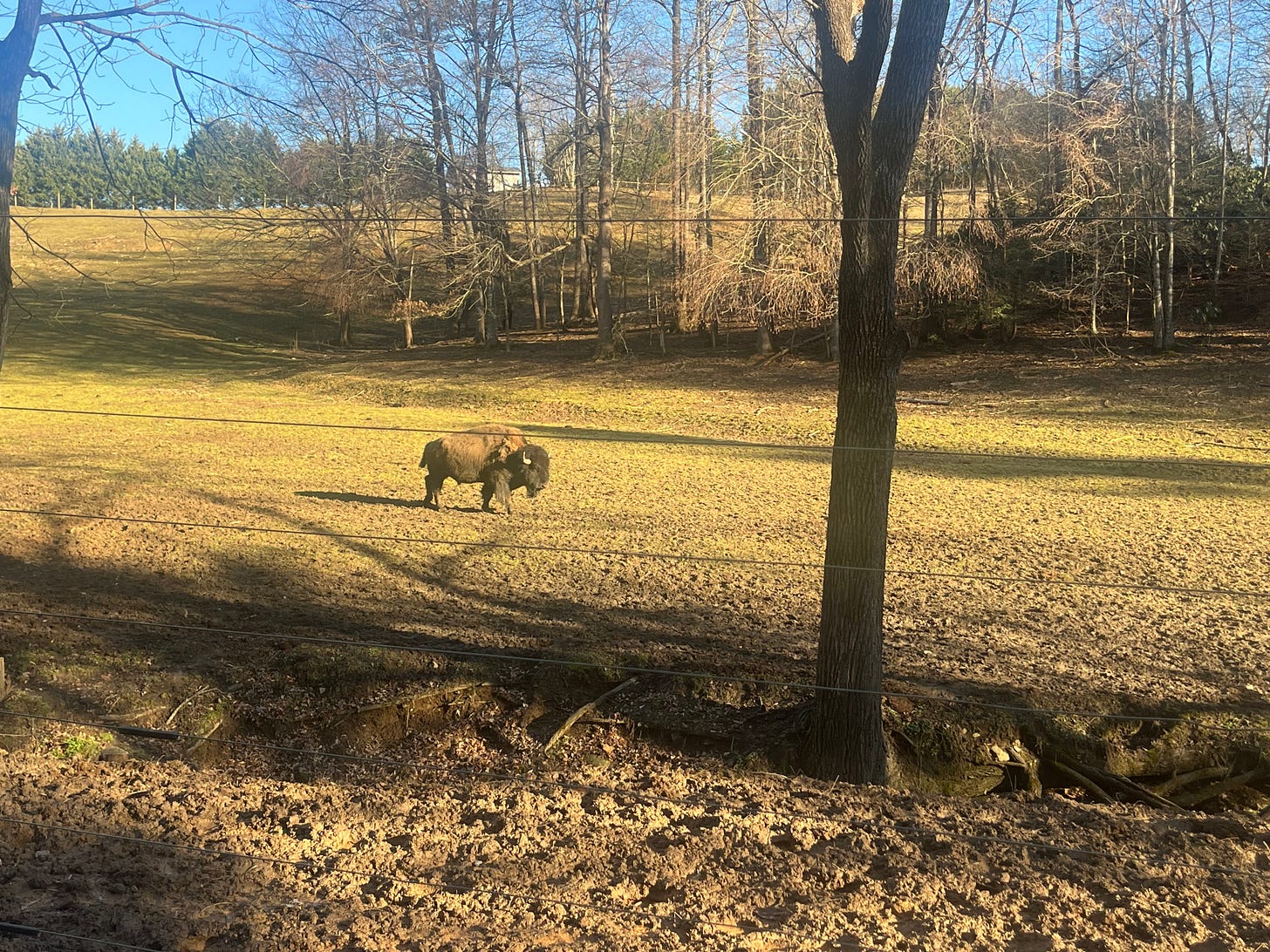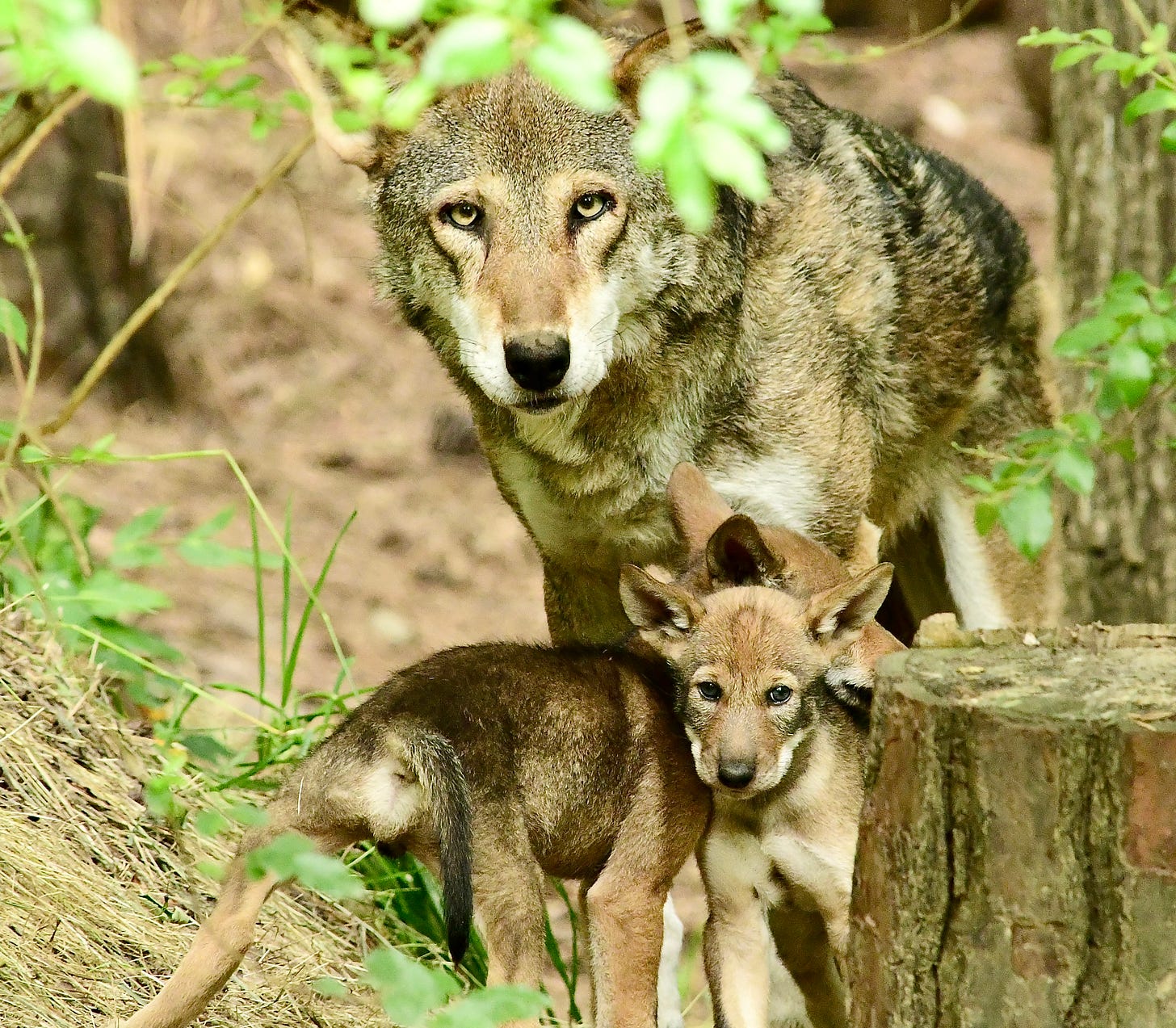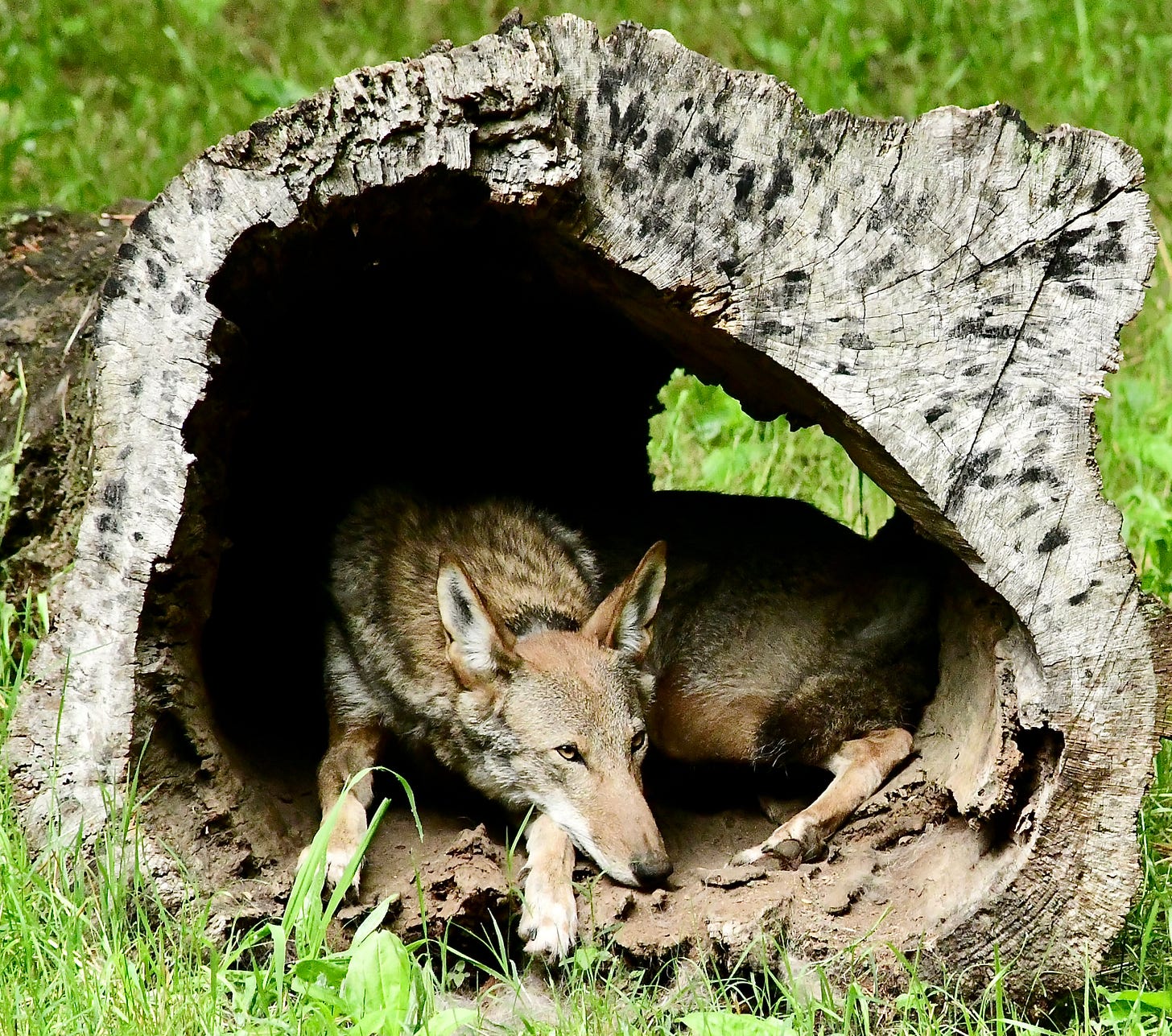I went to the mountains with my family last weekend. Just an overnight—but we went to an Ice Festival and stayed in a converted train caboose on a bison ranch; making the most of less than twenty-four hours, ha. We were in the Smokies of North Carolina, Haywood County to be specific, twenty miles west of Asheville—our first time back to the mountains since Hurricane Helene ravaged the region a few months ago.
The devastation that the storm brought to Western North Carolina is still hard to grasp. Countless homes and roads were washed away, not to mention entire towns in some cases. Rivers changed course. I didn’t know what to expect as we headed west, and ended up being struck on this brief visit both by the amount of destruction still evident—especially along river- and creek-sides, strewn with debris carried there from who-knows-where, and marred by splintered, maimed trees or the absence of trees altogether—and also by how beautiful the landscape remained in spite of everything that had happened.
A couple of weeks after Helene hit, I got an email alert informing me that the October “Howl-o-Ween” festival, celebrating red wolves at Western North Carolina Nature Center in Asheville, would move forward as planned but at an off-site location. “Due to significant flooding and impassable roads” in the region after Helene, the Center itself was to be closed indefinitely. “All our animals are safe and accounted for,” the website said, and the center itself suffered minimal damage in the storm—but both the main road and the bridge leading to the center had been washed away.
Biologist and passionate red wolf advocate Ron Sutherland wrote a fiery Facebook post in the immediate aftermath of the storm, when many North Carolinians were still shocked and grieving, making desperate collections and repeated trips taking emergency supplies to the west. In part, Ron pleaded with state leaders to make better choices when rebuilding, to not put homes in the same spots where they would be likely to experience flooding in the future. He pointed out that Native American community members who’d occupied the region long before its present occupants had shared wisdom about not building settlements in floodplains, but were largely ignored. He ended the post with a 1968 quote from North Carolina Governor Dan Moore, referencing the then-new installation of Interstate 40 in Pigeon River Gorge—a section of the highway along the Tennessee Border, not far from where we stayed near Maggie Valley, that completely collapsed in a Helene landslide and is still impassible: “The genius of modern man has shown itself to be superior to the adversities of nature.”
We’re not as clever or wise as we think we are, Ron wrote in reference to that quote. And nature bats last.
Good Samaritans and bad actors alike descended upon the chaos in Western North Carolina almost immediately after the storm subsided. In a time of unprecedented grief and confusion, neighbors banded together and federal, state and charitable organizations deployed to get much-needed supplies to hard-to-reach areas cut off from power, water or cell service. Independent armed militiamen appeared from out-of-state with machine guns to patrol, provide assistance and spread conspiracy theories that resulted in rampant violence, fear and misinformation. “My state is a cautionary tale,” Frank Bruni wrote in the New York Times, “of what happens when no corner of our lives is cordoned off from partisan exploitation and we lose our tether to the truth.”
He's right, I thought sadly as I read his piece, having puzzled over this partisan divide for the better part of five years now through the specific lens of an attempted species salvation gone sideways. (You can get a little nuts-and-bolts background on red wolf recovery in some pieces I’ve written for National Geographic, if interested; I’ll share more in this newsletter in posts to come).
Bruni was right about our tether to truth being lost—but it wasn’t severed completely, or so I hoped. Red wolves, in their assorted havens and sanctuaries, were still howling. A new breeding pair had just been moved to the museum near my house, another to the Red Wolf Education Center on the edge of the Pocosin Lakes Refuge in eastern NC where a few of them are still living, wild, with potentially more to come.
You can watch those wolves where they live under human care at any time on this wonderful webcam! It has a view of their enclosure and also inside their den. Remote wildlife cameras in general were such a balm during the worst days of pandemic lockdown…but that’s another post.
Photo by Robert Wilcox of father wolf “Adeyha” and 6-week-old pups at the Durham Museum of Life & Science
Ron’s comment regarding native insights going largely unheeded got me thinking about the red wolf’s long connection and sacredness to several first nations peoples, including the Cherokee and Tuscarora.
As part of a Center for Biodiversity project, members of the Tuscarora Nation in North Carolina were asked to name the members of the small family pack in the Pocosin Lakes Refuge. (You can hear a beautiful recording of the wolves’ names in the Tuscaroran language here). Even this naming was not without controversy; some wolf advocates feel that naming the wolves, rather than using the numbers assigned to them by the Saving Animals From Extinction (SAFE) program, anthropomorphizes them and thus puts them in greater danger of vulnerability to human interference, whether via habituation or hunting.
Impassioned spokesperson for local Tuscarora, Rahnàwakęw Donnie McDowell, told me, “Our history, along with that of our animal relatives, has not only been directly threatened through centuries of forced removal, colonization, and assimilation, it has been diminished by an opposing worldview that profits from the removal of certain species.”
Through my interactions with both historians and native peoples, I’ve learned more over the past couple of years about the sagas of tribes (like the Tuscarora) still fighting for federal acknowledgement and restitution of land they relinquished via bogus treaties centuries ago. Property rights are also at the root of much of the conflict over red wolf recovery in eastern North Carolina, which in many ways isn’t even about wolves—I’ve heard this from parties on both sides—but rather differing ideas of freedom: whether individual liberties should outweigh a collective good. A debate as old as this country.
“Oak” at the Museum of Life and Science in Durham, NC, photo by Robert Wilcox courtesy of Champions for Wildlife.
I’ll close out this entry with a short “Pandemic Dispatch” I wrote for the Harvard Review back in March of 2021… It reminds me of how much we have collectively been through as a country, and how far we still have to go:
Eastern North Carolina
I’m driving an empty stretch of road toward the Alligator River Wildlife Refuge at dusk, hoping to spot a wolf, when a roadside sign catches my eye. It’s been raining all day, alternating in sheets and spatters against the roof of the cabin where I’m staying at Stumpy Point. Daylight is fading, but I know I’ll forget about the sign later, and I’m curious—it looks like a historical marker of some kind. I pull onto the shoulder and read:
Dasemunkepeuc. Algonquian village at time of Roanoke voyages. Abandoned 1587 in this vicinity.
Through the windshield, the words blur and come into focus again with each pass of the wiper blades. Around me are acres of flat marsh and bogland, occasional clumps of shrubbery called pocosins, an Algonquian term for “swamp-on-a-hill.” The horizon is lost in mist. No trace of a village, which isn’t remarkable, given how long ago it was abandoned—but I’m surprised and a bit saddened regardless.
I’ve been preoccupied with disappearances lately. I’m working on a book about endangered red wolves, only ten of which are known to remain in the wild. They live nowhere else but here, on this swampy peninsula just west of the Outer Banks, which scientists predict will be underwater within a hundred years. Earlier today, I interviewed the biologist managing their recovery (seated, appropriately distanced, in our respective cars) and spent the remainder of the afternoon driving around trying to glimpse one. They are notoriously elusive, camouflaging with the landscape, but I have telemetry data from the biologist (the wolves all wear tracking collars), and know at least the general area in which they might be found.
The sun’s about to set, but I can’t resist taking out my phone and typing in Dasemunkepeuc. I learn it was likely a large village; the tribe’s leader called it home. When Europeans attacked in 1586, inhabitants were already dying of diseases colonists had brought. During the ambush, their chief was shot and fled to some woods, pursued by a colonist who later emerged carrying his severed head.
I pull back onto the road, and soon I’m cruising the puddled lanes of the refuge, navigating around deep ruts, scanning the fields for any movement. When last I was here, one year ago, I was just embarking on this project, excited about the discoveries ahead. Then the pandemic hit. I got sick in July, and I’m still sick: headaches, fatigue, hair falling out. Half a million Americans are dead. The counties surrounding this refuge are among the poorest in the state. Here, hunting is a way of life, and some people are necessarily more concerned with their own daily struggles than the fate of a few endangered canids. Biden won the election months ago, but Trump campaign signs and banners are still planted in front yards, still sagging over shop windows.
Wolves in North Carolina are either symbols of unconstitutional federal intrusion or untamed beauty. In reality, of course, wolves are just wolves. The Lakota people considered them another tribe that roamed the Great Plains—the Wolf Nation. I pull onto the shoulder, turn off the engine, roll my window down and squint into the rain. Somewhere, gliding through stands of cypress, black gum or loblolly, perhaps crouching in the reeds beside a black canal, the creatures I seek are waiting for darkness. I know I won’t see them, but still I linger—the night settling over me like a blanket, the rain drumming softly on the roof.







